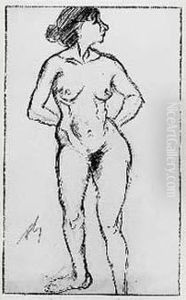Rupert Carabin Paintings
François-Rupert Carabin was a French sculptor and cabinetmaker, born on March 17, 1862, in Saverne, Alsace. Carabin's life and work were largely influenced by the Art Nouveau movement, which was at its peak in Europe at the turn of the 20th century. His work reflected the era's fascination with organic forms, eroticism, and the fusion of fine and decorative arts.
Carabin initially trained as a lithographer but found his true calling in sculptural work and furniture design. He was particularly known for his innovative use of materials and his ability to blend sculptural elements with functional pieces of furniture. His works often featured sculpted figures of women, which can be seen as both a celebration of the female form and an embodiment of the Art Nouveau ethos.
Throughout his career, Carabin exhibited his work at various salons and was well received by critics and collectors alike. He taught at the École des Arts Décoratifs in Strasbourg, where he influenced the next generation of artists. Despite his success, Carabin's work fell out of favor after World War I as tastes changed and the Art Nouveau movement gave way to new styles such as Art Deco and Modernism.
Rupert Carabin's contribution to the Art Nouveau movement was significant, and although his name may not be as widely recognized as some of his contemporaries, his work is highly regarded among specialists and collectors of the period. He died on December 1, 1932, in Strasbourg. Today, his work can be found in museums and private collections, serving as an enduring testament to his artistic legacy.
